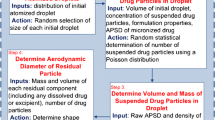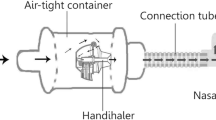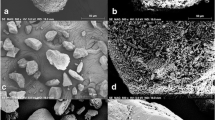Abstract
The delivery of particles as small as possible (preferably <5 µm) to the respiratory tract should be the aim of those formulating metered dose inhalers (MDIs). This may be facilitated by the formulation of solution, rather than suspension-type, pressurized aerosol units. Two series of MDIs were compared; one contained suspended micronized disodium fluorescein (0.1%, w/v), while the other contained the same concentration of dissolved salicylic acid. Either oleic acid, L-α-phosphatidylcholine, or sorbitan trioleate was incorporated at 0.15% (w/v) as suspending agent (disodium fluorescein) or solubilizing agent (salicylic acid). The propellant blend was 70% (w/w) Freon 12 and 30% (w/w) Freon 11 in all cases. This exhibited a vapor pressure of 50.6 psig (444.7 kPa) at 21°C. The output particle size distribution of the aerosol reaching the cascade impactor showed a mass median aerodynamic diameter (MMAD) of approximately 4 and 2 µm for the suspension and solution formulations respectively, regardless of the surfactant used. Larger MMADs were observed for solution aerosols formulated with oleic acid (2.32 µm) compared to those containing L-α-phosphatidylcholine (1.93 µm) or sorbitan trioleate (2.07 µm). Possible reasons for these observations are discussed.
Similar content being viewed by others
REFERENCES
P. R. Byron. Pharm. Tech. 11:42–56 (1987).
I. Gonda and P. R. Byron. Drug Dev. Ind. Pharm. 4:243–259 (1978).
P. R. Byron. Drug Dev. Ind. Pharm. 12:993–1015 (1976).
S. P. Newman. In S. W. Clarke and D. Pavia (eds.), Aerosols and the Lung: Clinical and Experimental Aspects, Butterworths, London, 1984, pp. 197–224.
S. P. Newman, G. Woodman, S. W. Clarke and M. A. Sackner. Chest 89:551–556 (1986).
P. König. Chest 88:276–284 (1985).
I. Gonda. J. Pharm. Pharmacol. 33:692–696 (1981).
P. R. Byron. J. Pharm. Sci. 75:433–438 (1986).
Physicians Desk Reference (41st ed.), Medical Economics Company, Oradell, N.J., 1987. p. 951.
Physicians Desk Reference (41st ed.), Medical Economics Company, Oradell, N.J., 1987, pp. 540–541.
I. Gonda. Int. J. Pharm. 27:99–116 (1985).
N. Dombrowski and G. Munday. In N. Blakebrough (ed.), Spray Drying in Biochemical and Engineering Sciences, Academic Press, London, 1968, pp. 209–320.
L. J. M. Bohnenn. Aerosol Age Sept:30–32 (1986).
F. Moren. Int. J. Pharm. 1:205–212 (1978).
F. Moren. Int. J. Pharm. 1:213–218 (1978).
F. Moren and J. Andersson. Int. J. Pharm. 6:295–300 (1980).
P. C. Reist. Introduction to Aerosol Science, Macmillan, New York, 1984, pp. 13–15, 40–49, 75–77.
C. C. Snead and J. T. Zung. J. Coll. Interface Sci. 27:25–30 (1968).
Y. Otani and Y. S. Wang. Aerosol Sci. Tech. 3:155–166 (1984).
T. Allen. Particle Size Measurement (2nd ed.), Chapman and Hill, London, 1975, pp. 74–112.
R. W. Rance. J. Soc. Cosmet. Chem. 25:545–561 (1974).
D. J. Shaw. Introduction to Colloid and Surface Chemistry (3rd ed.), Butterworths, London, 1980, pp. 98–105.
P. H. Elworthy, A. J. Florence and C. B. MacFarlane. Solubilization by Surface-Active Agents, Chapman and Hall, London, 1968, pp. 314–322.
J. H. Bell, K. Brown, and J. Glasby. J. Pharm. Pharmacol. 25 (Suppl.):32–36p (1973).
Author information
Authors and Affiliations
Rights and permissions
About this article
Cite this article
Dalby, R.N., Byron, P.R. Comparison of Output Particle Size Distributions from Pressurized Aerosols Formulated as Solutions or Suspensions. Pharm Res 5, 36–39 (1988). https://doi.org/10.1023/A:1015859311228
Issue Date:
DOI: https://doi.org/10.1023/A:1015859311228




